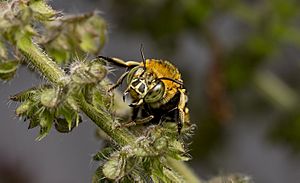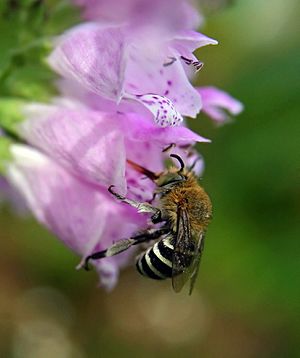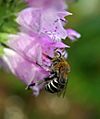Amegilla cingulata facts for kids
Quick facts for kids Amegilla cingulata |
|
|---|---|
 |
|
| Scientific classification | |
| Synonyms | |
|
The Amegilla cingulata is a type of bee known for its bright blue stripes. People often call it the blue-banded bee. These bees are originally from Australia, but you can find them in many other places too.
Scientists are studying how these bees help farms. They are very important for growing food. In Australia, blue-banded bees help with at least 30% of the crops. They do this using a special method called "buzz pollination".
Contents
What is the Blue-Banded Bee?
How Was A. cingulata Discovered?
The blue-banded bee was first described in 1775. A Danish scientist named Johan Christian Fabricius gave it its name. The word cingulata comes from a Latin word meaning "belt." This refers to the bee's striped bands.
There are over 250 other species in the Amegilla group. Some of them look very much like A. cingulata. This can make them hard to tell apart.
What Does the Blue-Banded Bee Look Like?
The blue-banded bee has a very unique look. It has bright, shiny blue stripes on its body. This is different from honey bees, which do not have these blue stripes.
You can tell male and female bees apart by their stripes. Male bees have five complete blue bands. Female bees, on the other hand, have four bands. These bees are usually about 10 to 12 millimeters long.
Where Do Blue-Banded Bees Live?
Distribution and Habitat of A. cingulata
Blue-banded bees are native to Australia. They are also found in places like Papua New Guinea, Indonesia, East Timor, and Malaysia. Some reports say they are in India, but these might be similar-looking bees.
These bees prefer warm, tropical, and subtropical areas. They can live in many different places. You might find them in urban areas, forests, woodlands, and heath areas. They live all over Australia, except for Tasmania.
Blue-Banded Bee Behavior
Do Blue-Banded Bees Sting?
Blue-banded bees can sting, but they are not as aggressive as some other bees. They tend to move very quickly.
How Do Blue-Banded Bees Live?
Male blue-banded bees often cling to plant stems at night. These bees are mostly solitary. This means they live alone, unlike social bees like honey bees that live in big colonies.
Female blue-banded bees build their nests by themselves. They dig burrows in soft sandstone or clay.
What Do Blue-Banded Bees Eat?
In Australia, blue-banded bees mostly collect nectar from blue flowers. They also visit other flowers. These include the mountain devil (Lambertia formosa) and grey spider flower (Grevillea buxifolia). They also like introduced plants like Abelia grandiflora and lavender.
They also feed on some non-blue flowers. Examples are white Salvia coccinea, tomato (Solanum lycopersicum), and eggplant (Solanum melongena) flowers. They also visit white flowers of Leea indica and some plants from the Verbenaceae family.
These bees use a special trick to get pollen. They hold onto flowers and vibrate their bodies strongly. This shaking helps release more pollen from the flower. They do not travel far from their nests to find food, usually about 300 meters. Female bees make at least nine trips to collect food each day.
Life Cycle of the Blue-Banded Bee
A. cingulata builds its nest alone. However, many bees might build their nests close to each other. They often nest in old river banks, old clay homes, or between bricks. They can also dig into soft sandstone. Areas with this type of rock can become full of bee tunnels.
At the end of these tunnels, the bee builds cells. Each cell holds an egg. The mother bee also puts a mix of pollen and nectar in the cell. This food will feed the baby bee (larva) when it hatches.
What Threats Do Blue-Banded Bees Face?
Many animals hunt blue-banded bees. These include cane toads, frogs, and birds. Their nests can also be attacked by another bee called the neon cuckoo bee (Thyreus nitidulus). This cuckoo bee lays its eggs in the blue-banded bee's nest.
Human activities can also threaten these bees. For example, clearing river banks, like those along the Caboolture River, can destroy their nesting places.
Images for kids
See also
 In Spanish: Amegilla cingulata para niños
In Spanish: Amegilla cingulata para niños




